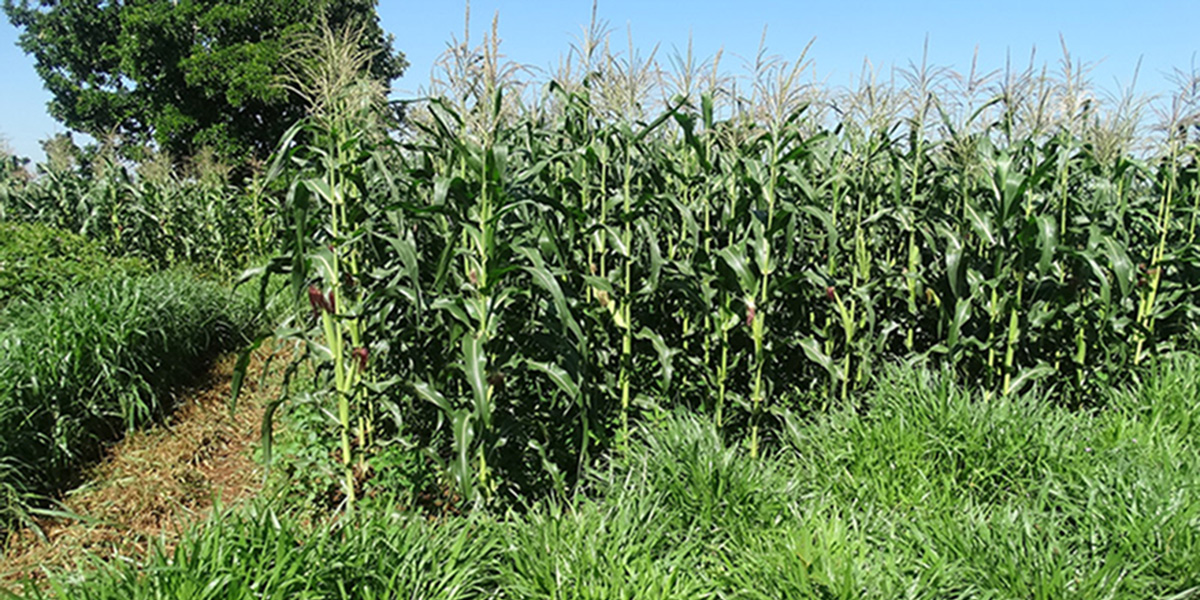
Agroecological method using companion planting succeeds against pest where GM has failed
Recently GMWatch reported on attempts by the GMO lobby to persuade African countries to accept GM Bt maize to fight the fall armyworm pest, which is spreading across the continent and ravaging maize crops. But the lobbyists omitted to mention that GM Bt insecticidal maize targeting the fall armyworm has already failed in different regions due to pests becoming resistant to the GM Bt toxins in the crop. The lobbyists also ignored the fact that agroecological methods, such as attracting ants to feed on armyworm eggs, are proving successful.
Now we've been alerted to another agroecological and non-GMO method that is working well in Africa as a defence against the fall armyworm. The method, a climate-adapted version of Push-Pull, is being spearheaded by the International Centre of Insect Physiology and Ecology (icipe), a multinational government-funded organisation that supports poverty alleviation and food security. A recent study based in East Africa shows that the method is effective in controlling the fall armyworm, providing an accessible, environmentally friendly, and cost-effective strategy for management of the pest.
icipe commented, "These findings represent the first documented report of a readily available technology that can be immediately deployed in different parts of Africa to efficiently manage the fall armyworm."
What is Push-Pull?
Push-Pull is an innovative companion cropping technology developed over the past 20 years by icipe in close collaboration with national partners in East Africa and Rothamsted Research, United Kingdom. It is modelled on the African smallholder farming system of multiple cropping.
Originally developed for the control of stemborers, the key pests of cereal crops across most of Africa, and parasitic Striga weeds, Push-Pull involves intercropping cereal crops with insect repellent legumes in the Desmodium genus, and planting an attractive forage plant such as Napier grass as a border around this intercrop.
The intercrop emits a blend of compounds that repel ("push") away stemborer moths, while the border plants emit chemicals that are attractive to ("pull") the pests.
Push-Pull has recently been adapted to drier areas through the incorporation of drought-tolerant companion plants. In addition, Push-Pull also controls maize ear rots and mycotoxins, while improving soil health and providing high quality fodder, since the companion crops are superior forages. Therefore, the technology facilitates crop-livestock integration thus expanding farmers’ income streams.
Armyworm infestation over 80% lower in Push-Pull fields
Prof Zeyaur Khan, Push-Pull leader at icipe and a co-author of the new study, said, “Over the past several months we received information from Push-Pull farmers that their fields were free of fall armyworm infestation while neighbouring monocrop plots were being ravaged by the pest. Therefore, we evaluated the climate-adapted version of the technology as a potential management tool for fall armyworm in Kenya, Uganda and Tanzania."
The study revealed fall armyworm infestation to be more than 80% lower in plots where the climate-adapted Push-Pull was being used, with associated increases in grain yields, in comparison to monocrop plots. The findings were supported by farmers' own observations of significantly reduced presence of fall armyworm in Push-Pull plots.
icipe director general Dr Segenet Kelemu commented, “The ability to manage such a devastating pest clearly demonstrates Push-Pull’s utility as a platform technology in addressing the multitude of challenges that affect cereal-livestock farming systems in Africa. icipe intends to continue disseminating the technology as widely as possible across Africa, while advancing studies to understand the scientific basis of its effectiveness against the fall armyworm."
Clearly development agencies should focus on helping farmers apply this safe and effective method across the African continent.
---
Publication details: Midega CAO; Pittchar JO; Pickett JA; Hailu GW; Khan ZR (2017) A climate-adapted push-pull system effectively controls fall armyworm, Spodoptera frugiperda (J E Smith), in maize in East Africa. Crop Protection. http://www.sciencedirect.com/science/article/pii/S0261219417303216
Report: Claire Robinson
Source and photo of maize crop protected by Push-Pull system: icipe http://www.icipe.org/news/icipe-push-pull-technology-halts-fall-armyworm-rampage










